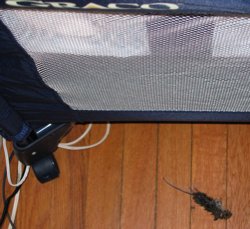Exceeding Expectations
Published 21 years, 10 months pastWhen I praised Apple yesterday for their repair service, I didn’t realize just how much praise was due. I was so excited to get my laptop back with working hinges, I hadn’t looked closely at the rest of the exterior. As TiBook owners know, the finish has a tendency to scratch. I’m not sure why that is, although I’m sure a Google search could yield all manner of answer, but the upshot is that the back of the display panel had a few nicks and dings; even a small dimple that prompted someone to ask if the laptop had stopped a bullet for me.
Now it doesn’t. The unknown technician replaced not only the hinges, but also the whole panel backing… and maybe even the whole display panel, screen and all. Now the machine looks as sharp and smooth as the day I bought it.
Let me be clear: those scrapes had nothing to do with the hinge problem. They were the result of “normal wear and tear.” There was absolutely no obligation on Apple’s part to do anything about them, any more than it would be Dell’s responsibility to replace a plastic surface on a Windows laptop that had gotten a scratch after half a year of ownership. While fixing the major problem, the unknown technician noticed that there was something else that could be fixed, and just went ahead and did it. No fuss. It wasn’t even noted on my repair history. It was just done.
I’ve never been sorry to buy Apple products. Now I’m actually proud to be a customer.
As a postscript, I’d like to point out that mine is an older-model Powerbook. The new ones have a much more scratch-resistant surface, and a totally different hinge system. On the new ones, there’s a single large and sturdy hinge that runs most of the width of the machine, occupying about the same amount of space as the gap between my hinges. They have other improvements too, like a backlit keyboard and ports on the sides instead of in the back, and I wish I could have waited another two months to buy my laptop so I’d have one of the new ones. Nothing wrong with mine—the new ones are just cooler.
For those of you using an RSS aggregator, you’re probably going to see all of my entries turn up as new a few more times. I’m adjusting the way I produce the feeds to include an indication of the post length and the categories to which the post belongs as text at the end of the feed description. I may also modify it to include the first sentence of each paragraph instead of just the first sentence of the entire post.
Incidentally, a few of you have asked why I don’t provide the complete post content in my feeds. For me, it’s a bandwidth issue. I was looking over the access statistics for January, and was astonished to find that the two RSS feeds together were accessed over 189,000 times. The home page, by comparison, was hit over 53,000 times. The latter accounts for 9.3% of the outgoing bandwidth; the two feeds together add up to 1.54%. If I were to have the feeds contain full posts, that would increase RSS-feed bandwidth by an order of magnitude at least. It would also reduce the number of 304 (Not Modified) responses the server returns for the RSS files, because I do go back and correct spelling errors and such. The feeds don’t have to be updated when I do, but they would if I provided full post content.
I do have sympathy for those of you using aggregators like NetNewsWire (I’m using the Lite version, myself) and FeedDemon. I’d have more sympathy for LiveJournal users if the LJ server returned 304s, but it never does, forcing me to download the whole feed every time I ask for updates. So I did consider the syndication experience from the user’s point of view. I also have to consider the impact on the server, and frankly, given the way RSS is designed, the potential impact is just too high for me to move to full-content feeds.
So now you know.
 Longtime readers may recall I had
Longtime readers may recall I had  From what I understand, this is typically how mother-cats feed their children, and start training them to hunt for their own food. I wished there were some way to communicate to Gravity that she could have her hunting spoils back, since Carolyn’s fairly well fed even without rodent supplements. When you think about all this, it’s really rather touching, in a morbid way. Kat and I both got a pretty good laugh out of it.
From what I understand, this is typically how mother-cats feed their children, and start training them to hunt for their own food. I wished there were some way to communicate to Gravity that she could have her hunting spoils back, since Carolyn’s fairly well fed even without rodent supplements. When you think about all this, it’s really rather touching, in a morbid way. Kat and I both got a pretty good laugh out of it.